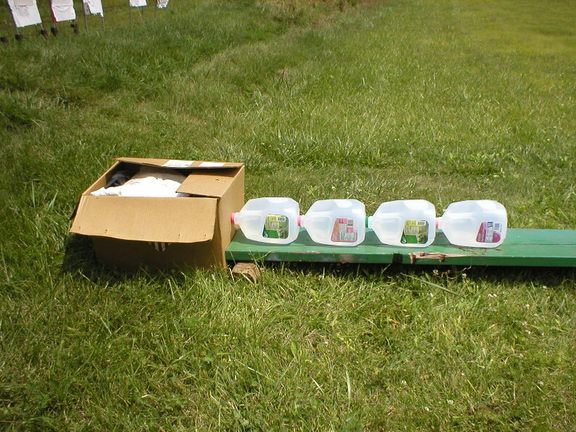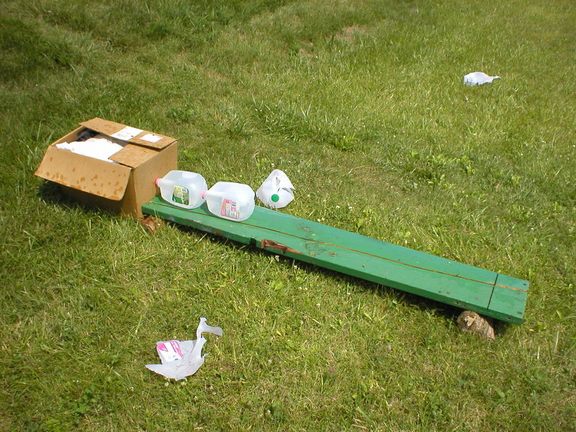



 The Accurate Reloading Forums
The Accurate Reloading Forums  THE ACCURATE RELOADING.COM FORUMS
THE ACCURATE RELOADING.COM FORUMS  Hunting
Hunting  American Big Game Hunting
American Big Game Hunting  Bullet Testing
Bullet TestingGo  | New  | Find  | Notify  | Tools  | Reply  |  |
| one of us |
Bullet Testing Material Has anyone got personal experience with Corbin's SIM-TEST ballistic media ? http://www.corbins.com/sim-test.htm Hammer | ||
|
| one of us |
Whoa, that stuff sure looks interesting. I've been digging bullets out of clay and game for a long time. Saw something just like this on CSI last Thursday night. Hope somebody gives this a try. I would be glad to, but $98 + is a bit hard to justify. | |||
|
| one of us |
The best simulated rifle hunting testing I have heard about is Bob Hagel's bullet box. He made a long box and filled it with sawdust? and bones. Then he went out and shot lots of everything to prove it in the field. Now Bob is a professional and at the cutting edge. For myself I just shot deer and bear with a .358 Winchester. Not much new there as they all die really quick. I have been comparing bullets by shooting them into a line up of 1/2 gallon paper cartons filled with water. This has been going on for forty years. I have lots of little plastic bags with the remains and a note in each of how many cartons were blown up and penetrated. This is not that hard to clean up and it's free. That Corbin product seems to be way too much trouble. Just imagine picking all that gunk up and trying to save what's left of a C' note of it and then melting it again. Good greif. If you have some property with say 200 yd range then build a Hagel bullet box out there from scrap lumber or logs. That should keep you busy till opening day. Or if your lazy like I am just use enough gun. | |||
|
| one of us |
Here's my set-up.  And after a 165 interbond hit them at 3000 fps.  Best part of it is it's repeatability and it's almost free. A problem with water is there's no way to view a wound channel. Except for high speed photagraphy maybe! As for the corbin material, if my ship ever comes in-----that would make an excellent material to test in. The CSI episode showed the preparation of ballistic gelatin. That's been used for many years for bullet testing. It's expensive, perishible and can only be used once. Joyce Hornady used wetlap, which is wood pulp before it's made into paper. Grand Island Nebraska was a big paper town, maybe still is. He could get all he wanted of the stuff, it made a good test medium. | |||
|
| one of us |
Talked directly to Dave Corbin today about his SIM-TEST ballistic media. SIM-TEST material can be diluted by any amount desired, but that is not recommended for comparison purposes to other labs' results. NATO, FBI, and other folks use it "as is". They have lots of data comparing it as delivered. Preparation involves heating it to 160 degrees F for melting and pouring into molds. Figure a one hour cycle between completing shooting it and observing results to then remelt, pour new blocks, and shoot again. Normally keep two sets going so that one was remelting while another was being used for tests. Asked about waiting a day or two for material stabilization, Corbin said that while waiting would be good, it is definitely not necessary or normal use. By the time it solidifies in the pan it has cooled to 100 degrees. It is normally used at ambient room temperature that is attained by the time the material blocks are set and shooting resumes. Quick recycling and a broad range of ambient use conditions seem to be major strong points. Kept in a styrofoam ice chest, some users have been recycling the same material for over five years. A correlation between SIM-TEST and 10% ballistic gelatin can be made similar to a correlation between Fahrenheit and centigrade. However, just like the temperature correlation, the numbers won't be the same. SIM-TEST is tougher than 10% ballistic gelatin. The bullets will penetrate less and expand more in SIM-TEST. SIM-TEST more closely compares to tough animal muscle tissue (elk, bear) while 10% ballistic gelatin compares closer to human tissue. 10% ballistic gelatin is better for photographic purposes. SIM-TEST material is edible, but not necessarily tasty (Corbin compared it to vanilla-flavored cappuccino). It does have a natural anti-bacteria additive that can be replenished when the material is melted if one wanted to. Without the anti-bacteria additive, this same stuff is used to feed bacteria in medical labs. It is similar to bookbinder's glue but is not the exact same. Price is $98 per 60 pound carton plus shipping. Two cartons is a typical non-commercial order. Six cartons is a pallet with some price break. Hammer | |||
|
| one of us |
Sounds like animal glue. | |||
|
| one of us |
May be. Hammer | |||
|
| One of Us |
I agree with Grizz the gallon milk jugs are pretty universally available here in the US at least. I set them side to side, gives less area to penetrate per jug, but seems to be more uniform if the hit's a bit off center. Problems with the jugs are the mess and you occasionally lose a bullet that veers off to the side. I keep threatening to build a Fackler box that uses gallon ziplock bags but just haven't yet. Corbin's stuff may be good but it looks like a $300.00+ outlay once you get all the material and equipment to handle it properly. | |||
|
| Powered by Social Strata |
| Please Wait. Your request is being processed... |
|

Visit our on-line store for AR Memorabilia

